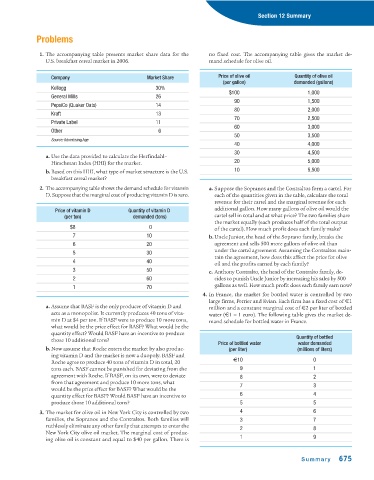Page 717 - Krugmans Economics for AP Text Book_Neat
P. 717
Section 12 Summary
Problems
1. The accompanying table presents market share data for the no fixed cost. The accompanying table gives the market de-
U.S. breakfast cereal market in 2006. mand schedule for olive oil.
Company Market Share Price of olive oil Quantity of olive oil
(per gallon) demanded (gallons)
Kellogg 30%
$100 1,000
General Mills 26
90 1,500
PepsiCo (Quaker Oats) 14
80 2,000
Kraft 13
70 2,500
Private Label 11
60 3,000
Other 6
50 3,500
Source: Advertising Age
40 4,000
30 4,500
a. Use the data provided to calculate the Herfindahl–
Hirschman Index (HHI) for the market. 20 5,000
b.Based on this HHI, what type of market structure is the U.S. 10 5,500
breakfast cereal market?
2. The accompanying table shows the demand schedule for vitamin a. Suppose the Sopranos and the Contraltos form a cartel. For
D. Suppose that the marginal cost of producing vitamin D is zero. each of the quantities given in the table, calculate the total
revenue for their cartel and the marginal revenue for each
Price of vitamin D Quantity of vitamin D additional gallon. How many gallons of olive oil would the
(per ton) demanded (tons) cartel sell in total and at what price? The two families share
the market equally (each produces half of the total output
$8 0 of the cartel). How much profit does each family make?
7 10 b.Uncle Junior, the head of the Soprano family, breaks the
6 20 agreement and sells 500 more gallons of olive oil than
under the cartel agreement. Assuming the Contraltos main-
5 30
tain the agreement, how does this affect the price for olive
4 40
oil and the profits earned by each family?
3 50 c. Anthony Contralto, the head of the Contralto family, de-
2 60 cides to punish Uncle Junior by increasing his sales by 500
1 70 gallons as well. How much profit does each family earn now?
4. In France, the market for bottled water is controlled by two
large firms, Perrier and Evian. Each firm has a fixed cost of €1
a. Assume that BASF is the only producer of vitamin D and million and a constant marginal cost of €2 per liter of bottled
acts as a monopolist. It currently produces 40 tons of vita- water (€1 = 1 euro). The following table gives the market de-
min D at $4 per ton. If BASF were to produce 10 more tons, mand schedule for bottled water in France.
what would be the price effect for BASF? What would be the
quantity effect? Would BASF have an incentive to produce
those 10 additional tons? Quantity of bottled
Price of bottled water water demanded
b.Now assume that Roche enters the market by also produc- (per liter) (millions of liters)
ing vitamin D and the market is now a duopoly. BASF and
Roche agree to produce 40 tons of vitamin D in total, 20 €10 0
tons each. BASF cannot be punished for deviating from the 9 1
agreement with Roche. If BASF, on its own, were to deviate 8 2
from that agreement and produce 10 more tons, what 7 3
would be the price effect for BASF? What would be the
quantity effect for BASF? Would BASF have an incentive to 6 4
produce those 10 additional tons? 5 5
3. The market for olive oil in New York City is controlled by two 4 6
families, the Sopranos and the Contraltos. Both families will 3 7
ruthlessly eliminate any other family that attempts to enter the 2 8
New York City olive oil market. The marginal cost of produc-
ing olive oil is constant and equal to $40 per gallon. There is 1 9
Summary 675

